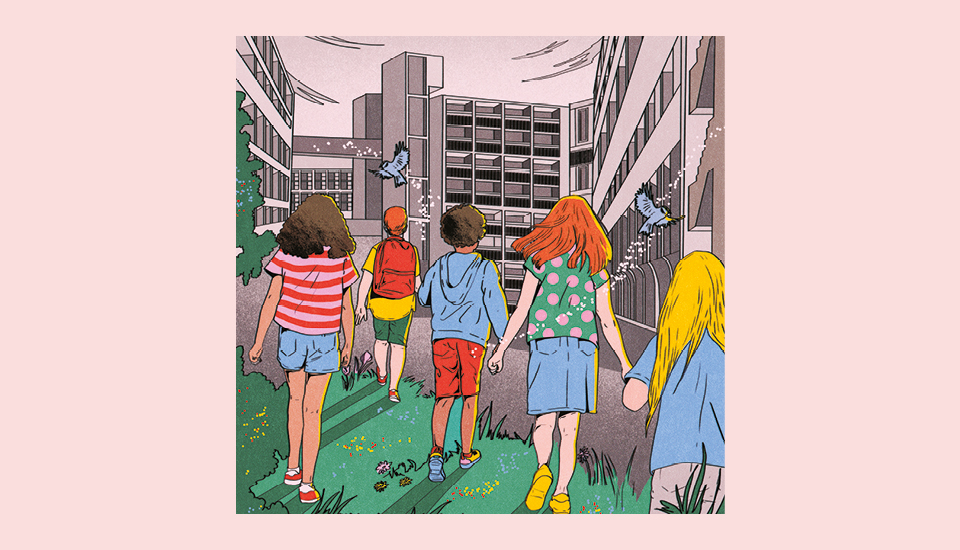We need swift and radical change in capabilities, innovation and investment to save the planet.
As the global youth population swells and access to education improves, more young people are enrolling in formal education systems, driving their aspirations for the future in a way their grandparents could only dream of. These young people will be tomorrow’s leaders; many are today’s changemakers, already taking action locally, nationally and globally to respond to the challenges we face. According to the World Bank, there are 220 million students in tertiary education today, a staggering rise of 100 million compared with 2020; what jobs await them in five, 10 or 20 years, if at all?
According to the International Labour Organization (ILO) in 2022 there are 68 million people looking (and available) for work (ie, unemployed), a situation only exacerbated by the pandemic, which took a huge toll on global jobs particularly for young people, women and marginalised people. The ILO data shows that work hours lost in 2020 represent more than 250m full-time jobs. The pressure that the pandemic has put on educational and training institutions has already caused significant disruptions in learning at all levels, including the hiring of new graduates.
The planetary crisis
This year marks the 50th anniversary of the United Nations Conference on the Human Environment held in Stockholm, Sweden in 1972. Over the last half century, the economy and human wellbeing have progressed substantially. Many people have been lifted out of extreme poverty and benefit from improved access to health systems and education, although there is still much work to be done. We are also facing new challenges, namely, the triple planetary crisis: climate change, biodiversity loss and pollution. Climate shocks forced 30 million to flee their home countries in 2020. Three times that number were displaced by war and violence. A 2021 report from the Intergovernmental Panel on Climate Change (IPCC) and Intergovernmental Science-Policy Platform on Biodiversity and Ecosystem services (IPBES) shows that 77% of our land (excluding Antarctica) and 87% of our oceans have been modified by human activities. Some 60% of wild animals have disappeared over the last 50 years with a million further species currently facing extinction, while 11m tonnes of plastic are poured into our oceans every year.
Many of these environmental crises are driven by patterns of unsustainable consumption and production to meet the demands of growing populations. According to Global Footprint Network, today more than 80% of the world’s population lives in countries that are using more resources than the earth can regenerate. If we continue current consumption and production patterns, we will need three planets to sustain the lifestyles of an estimated 9.7 billion people by 2050.
Through Covid-19, the planet warned us to change our course; 60% of known and 75% of all emerging infectious diseases are zoonotic. Household consumption drives 72% of global greenhouse gas emissions and these human activities modify wildlife structure, resulting in new conditions that favour particular hosts, vectors and pathogens. Ecosystem integrity is the foundation of human health and development, and it requires us to rethink our relationship with nature, lowering the risk of future pandemics. This means transforming social and economic systems by investing in nature and greener economic activities.
Combined, young people’s sustainable lifestyle choices have an enormous positive impact on our economy, society and the environment
Multiple studies show young people today would choose to work for a sustainable company for lower pay. The annual consumption power of Millennials currently sits around $68bn (£50bn) while Generation Z accounts for roughly $100bn (£74bn), equivalent to the annual cost of meeting the United Nations’ Sustainable Development Goal (SDG) 6, which targets clean drinking water, sanitation and hygiene. Combined, young people’s sustainable lifestyle choices have an enormous positive impact on our economy, society and the environment.
The green transition
According to the ILO, transition to a green economy – moving from a linear economy to a circular economy – will not only reduce the burdens on our ecosystems but also add an estimated 60m new jobs to the market by 2030. In addition, nature-based solutions provide huge positive potential for creating green jobs. Ecosystem restoration generates an estimated $7-$30 (£5-£22) in benefits for every dollar invested. Nature-based solutions create between seven and 40 jobs per $1m invested, which is 10 times the job creation rate of investments in fossil fuels. At COP26 in Glasgow in 2021, we saw the first concrete signs of a move towards ending coal and fossil fuel subsidies, hinting at the eventual obsolescence of fossil fuel dependent industries. All of this points to significant changes in job profiles, including in those that do not yet exist.
How will we prepare the future and current workforce with the necessary skills, knowledge and opportunities to meet the new demands made by a green economy? Even among those with jobs, nearly 1 billion workers globally are experiencing a skills mismatch, which means available jobs do not match their educational level. We need to be able to quickly respond to the ever-changing skills needs in society by ‘upskilling’ these workers. New 2021 guidance published by the United Nations Environment Programme (UNEP) identifies four key actions to make sure no one is left behind as we make this transition.
First, we need a major change in mindset that looks at every job through a green lens. ‘Green jobs’ go beyond just positions for solar power engineers, or other roles typically linked to sustainability. Any job that involves decisions about how and which resources to consume can be a green job, from simple choices such as ordering office supplies to choosing energy sources and designing products. Many people will be able to remain in their current roles but will need to reskill and/or upskill, in order to work in a more sustainable way. Jobs such as these are key to ecosystem restoration, economic growth and poverty reduction and are increasing faster than other types of jobs, meaning every country is well suited to benefit from green jobs.
Second, we need to update education to ensure a stronger supply of necessary green and environmental sustainability professionals. To do so requires curriculum changes, skills gap identification, and making connections with the demand side of the job market. This includes guidance on increasing job placement of students, improving the quality of curricula to meet career pathway and employer needs, connecting students to practitioners for applied projects/research, and enhancing green entrepreneurship. Students can then bring their sustainability literacy to any job to help create a greener economy, acting as green intrapreneurs for organisational change.
On this point, it is important to note that, to be successful at greening a company, students must be able to understand how to assess the organisation’s formal and informal power structure as well as its products and processes, identifying opportunities for greener practices and building the coalition of support necessary to create changes. To achieve this, students must first be exposed to systems thinking and effective change management approaches. Educating young people for an inclusive and green economy enables them to apply this knowledge not only to their professions but also to their roles as consumers, voters, community members and investors.
Third, we must strengthen cross-sector collaborations. The education sector will gain from working closely with businesses, governments, local communities, and non-profit organisations and associations, because co-creating the vision for a green economy has the potential to produce necessary financing, policies, market demand, training and education for the new and existing workforce. According to an August 2017 UN Secretary General report on human resources development for the 21st century, “closer collaboration will also be required across government ministries in order to devise integrated strategies encompassing public policies in the areas of education, youth, industrialisation and rural development.”
Lastly, governments must assess which sectors are driving positive environmental impacts in respective countries. Some of the jobs with significant positive environmental impacts are within the energy, agribusiness and digital innovation sectors. A 2021 UNEP report on green youth skills explored how technologies are changing, and how a circular economy might change the type of jobs that are available.
ILO research from 2018 shows the energy sector accounts for the largest share of current and future green jobs, especially the infrastructure and renewable energy sectors. For instance, the renewable energy sector employed 11.5 million people in 2019. With added investment, jobs in renewables could reach 42m by 2050, with another 21.3m jobs in energy efficiency and 14.5m people in jobs related to power grids and energy flexibility. In the meantime, the study estimates, only two industries will experience losses of more than 1m jobs, namely petroleum refining and extraction of crude petroleum.
Adoption of sustainable management practices in agriculture, forestry and fisheries will account for 362m-630m job gains by 2050, according to figures from the UN’s Food and Agriculture Organization (FAO). The world’s population is expected to increase by 2 billion people in the next 28 years, from
7.9 billion currently to 9.7 billion in 2050. How are we going to feed everyone? Over a quarter of available land is used for cattle grazing and 33% of arable land is used for feeding livestock, per FAO figures. Although crucial to reaching the goal of sustainable development, organic farming, sustainable agriculture and green food manufacturing are more labour intensive than conventional production.
As well as sustainable procurement policy, the use of climate-smart technology will help agribusiness and fisheries to ensure that the entire value chain becomes more innovative and sustainable. Indeed, the ILO’s World Employment and Social Outlook highlights the need for new business models, digital literacy and technological innovations to respond to the continued rise of the digital labour platforms and economies.
The Sustainable Development Goals
All aspects of the green economy and just transition are interrelated with sustainability challenges, and therefore to the UN’s 17 SDGs, which are at the heart of the 2030 Agenda for Sustainable Development adopted by all UN member states in 2015. Correspondingly, green jobs have several direct and indirect connections with these goals.
For example, SDG 4 supports the promotion of green jobs through its dedicated targets such as the promotion of technical and vocational skills for employment, decent jobs and entrepreneurship, which will ensure that the knowledge and skills acquired promote sustainable industries. SDG 7 has specific targets to promote renewable energy and energy efficiency, along with improved energy access, expanded infrastructure and upgraded technology; these are also the main sectors involved in our move towards a greener economy and therefore opportunities for green jobs.
In addition to committing to entrepreneurship and to the creation of decent jobs for all, SDG 8 supports green jobs with its focus on improving global resource efficiency in consumption and production. Making cities and communities more sustainable (SDG 11) encompasses multiple aspects, such as sustainable transport systems, sustainable urbanization and management, and implementation of policies on resource efficiency, climate action and resiliency, which are all opportunities for green jobs. SDG 12 has core aims of sustainable production and consumption; green jobs will also have the expected outcome of improving raw materials efficiency and eliminating waste and pollution. Finally, green jobs are concerned with the impact of climate action while promoting adaptation and mitigation strategies. SDG 13 focuses on climate action and has targets to support these connections, including capacity and awareness raising.
Shifting systems
There is a vast gap in climate financing. A radical transformation of the financial system is needed to achieve low-carbon, sustainable development for a greener world. Shifting investment towards sustainable solutions through science and innovation in developing countries is key to ensuring the achievement of SDGs by 2030 and a carbon-neutral world by 2050, while also bending the curve on biodiversity loss and curbing pollution and waste. Governments should incorporate natural capital accounting into decision-making and incentivise business to do the same, for instance through carbon pricing, phasing out of harmful subsidies, shifting taxation to resource use and waste, and reforming fossil fuel subsidies. We also need a global commitment within the next two years to put half of all climate finance towards adaptation.
Yet, despite more than 130 countries having pledged to reach net zero by 2050 at COP26 in Glasgow, recent analysis revealed commercial banks and investors channelled $1.5tn (£1.1tn) to the coal industry between January 2019 and November 2021, positioning themselves as the world’s worst climate offenders. In addition, world military spending rose to almost $2tn (£1.5tn) in 2020, pushed by the economic downturn, according to Stockholm International Peace Research Institute. Almost three-quarters of nations have some adaptation plans in place, but financing and implementation fall far short of what is needed. Annual adaptation costs in developing countries are estimated at $70bn (£51.5bn). This figure is expected to reach $40bn-$300bn (£29.5bn-£220.8) in 2030 and $280bn-$500bn (£206bn-£368bn) in 2050. However, in the absence of improving absorptive capacity, it would be more effective to focus primarily on the policy and institutional environment in forming strategies to realise the plans than in raising more funds. A sound policy framework and governance are prerequisites for optimising the sustainability of investments in tackling climate change and building the green economy as well as society.
Lastly, the integration of gender equality into economic and social policies is a fundamental requirement for sustainable development. Although progress in achieving gender parity in the workplace has been seen, women are still more likely than men to have jobs that are vulnerable, insecure, lower paid and less formal. In addition, women are disproportionally affected by climate change, as it affects the poor and most vulnerable, among which a majority are women. According to 2015 figures published by the International Union for Conservation of Nature (IUCN), women tend to have the knowledge and understanding of what is needed to adapt to changing environmental conditions and to come up with practical climate change adaptation and mitigation solutions.
Additionally, in 2011 the Organisation for Economic Co-operation and Development (OECD) and World Bank confirmed that putting more income in the hands of women translates into beneficial results for general human development, as women tend to invest more in children’s nutrition, health and education. Therefore, addressing gender imbalance in defining economic and social targets and integrating gender equality into green economic policies allows for fairer distribution of opportunities and wealth to the country’s population and its economy. The gender pay gap and access to finance, lands, political and economic participation, and education correlate with nations’ long-term competitiveness in the green economy.
Green skills future
Young people today are more informed and outspoken about environmental issues than ever. Increasingly they are using their voices and turning this energy into action, becoming changemakers. They are doing what we all should be doing, which is recognising that every lifestyle decision counts, whether choosing to recycle their old phones or deciding on the food they buy or how they travel. Rethinking how we consume directly affects the economies and global resource use of our countries, and therefore ecosystems and the climate.
We should be teaching young people not only the importance of voting at the ballot box, but with their finances. Most of our money is not sitting in the bank but is invested elsewhere, often without us knowing where. By choosing ethical banks and insurance companies, we can accelerate the move away from brown industries, thus creating more green jobs. In addition, by voting for leaders who value green policies, we contribute to building a greener society.
More young people will also set up their own green businesses; many of the jobs necessary for an inclusive and green economy do not yet exist but can be created by green entrepreneurs. Such entrepreneurs have already created many career pathways such as energy managers and energy auditors, solar photovoltaic manufacturers, clean cooking stove providers and carbon offset retailers, to name just a few.
But even though young people may own the future, they are not supposed to own the planetary crisis. Policymakers, businesses, educators, communities and parents are responsible for laying the foundation and environment for young people to fulfil their potential and aspirations towards a sustainable future. It is up to all of us to put in place the systems and infrastructure to support the teaching of green skills and their anchoring into existing and new economies. Many, many more future green jobs are out there just waiting to be invented.
The views expressed in this publication are those of the author and do not necessarily reflect the views of the United Nations Environment Programme.
Mari Nishimura is a Programme Management Officer in the Executive Office of the United Nations Environment Programme, previously focused on SDG 12 and education.
This article first appeared in the RSA Journal Issue 1 2022.
To correct this error:
- Ensure that you have a valid license file for the site configuration.
- Store the license file in the application directory.
Related articles
-
Young at heart
Journal
Jonathan Prosser
Becoming a nation with children at its centre in 10 courageous steps.
-
Open RSA knowledge standards
Blog
Alessandra Tombazzi Tom Kenyon
After investigating ‘knowledge commons’, we're introducing our open RSA standards and what they mean for our practice, products and processes.
-
Worlds apart
Comment
Frank Gaffikin
We are at an inflexion point as a species with an increasing need for collaborative responses to the global crises we face.




Join the discussion
Comments
Please login to post a comment or reply
Don't have an account? Click here to register.
We need more cohesion and hope in innovation and new ways of 'conducting' electricity- beyond wind & sun. Grid demand UK will double in next decade, but no provision/scope/investment for meeting that need in a modern way. The 'biggest', most abundant and most dependable source of energy on our Planet is in the swell and plunge of our tidal oceans- am optimising new 'hydro-hermetic' discovery 'LPD' with Exeter Uni Marine Energy R&D and will share progress. Any queries/suggestions/connections welcome. xjam